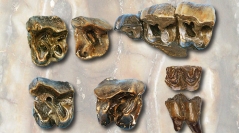

 Geodiversitas
39 (2) - Pages 251-271
Geodiversitas
39 (2) - Pages 251-271The paleontological site of Le Grand Morier is located in the heart of the Ligerian Basin, 40 kilometers West from the city of Tours (Temey 1996). This fossiliferous site corresponds to an old quarry where the Miocene shelly sand was exploited (Fig. 1). The most important geological and paleontological studies of Le Grand Morier are those of Lecointre (1930, 1947), Alcaydé (1975) and Alcaydé et al. (1976) for the geological surveys (geological mapping, stratigraphy and structural studies) and of Buge (1948) and Ginsburg (2001) for their work on the fossils (bryozoans and Miocene land mammals respectively). This article presents original data on the geological context and the stratigraphy of the Cenozoic sedimentary series of Le Grand Morier site (Fig. 2). Cenozoic outcrops are numerous and diversified in Anjou-Touraine (Lecointre 1947). Looking at the regional geological maps is enough to realize that the Cretaceous is covered by continental Paleogene formations and marine Neogene formations (Alcaydé & Rasplus 1971; Alcaydé 1975). To our knowledge, Le Grand Morier is the only known site in Anjou-Touraine with exposures of all Cenozoic formations (albeit small outcrops for some of them), from the Paleocene-Eocene “perrons de Touraine” to the Late Miocene to Pliocene gravel sands (Fig. 4). This site is exceptional because vertebrate fossils have been found in each outcropping formation. In addition, this paleontological site is located into a local tectonic structure: the Pont-Boutard graben (Fig. 3). Integrating the structural and stratigraphic clearly shows that the Cenozoic sedimentation is a syntectonic sedimentation constrained and channeled by the structurally-active Pont-Boutard graben. Specifically, the establishment of the continental formations (fluviatile and lacustrine deposits) during the middle Cenozoic (Eocene to earliest Miocene) was made possible by the formation of a basin controlled by two faults activated by the Pyrenan orogeny (Fig. 2). The Alpine orogeny (Miocene) accentuated the deepening of the Pont-Boutard graben, safeguarding a major part of the Cenozoic sedimentary series (Paleocene to Miocene), but also redirecting the prograding marine sediments from the basin of Savigné-sur-Lathan/Noyant-sous-le-Lude towards the basin of Paulmy in Southern Touraine. By compiling all the geological (stratigraphy, sedimentology, and taphonomy) and paleontological data, it is possible to consider six successive assemblages of vertebrate faunas (102 taxa), reworked or not. The assemblage no. 1 contains one tooth of Plagiolophus cf. annectens (Owen, 1847) (Fig. 7); found in the Middle to Late Eocene lacustrine green clay (MP12 to MP20). The assemblage no. 2 contains four land mammals either Oligocene (Ronzotherium cf. romani: MP24-29) or Early Miocene in age (Agenian-Aquitanian): Phoberocyon hispanicus Ginsburg & Morales, 1998, Protaceratherium minutum (Cuvier, 1822-1824), Paratapirus intermedius (Filhol, 1885) (Fig. 7). The fossils have been found in the lacustrine limestone underlying the Miocene marine shelly sand. It is an important new input for the Cenozoic biostratigraphy of the Anjou-Touraine area. This lacustrine limestone known as “le calcaire lacustre de Touraine”, has always been dated as Late Eocene to Oligocene (Alcaydé 1975; Yvard 1976). The presence in our site of land mammals similar to the fossils observed in the Early Miocene locality of Selles-sur-Cher (Loir-et-Cher, France, Ginsburg & Hugueney 1980; Antoine et al. 2000) together with a typical Oligocene rhinocerotid enables us to consider that geological formation may range from the late early Oligocene to the Agenian, MP24 to MN2 (Bruijn et al. 1992; Aguilar et al. 1997). The assemblage no. 3 is exclusively composed of well-known Miocene marine vertebrates (fishes and mammals): Isurus desori, Cosmopolitodus hastalis, Otodus megalodon, Carcharias (Odontaspis) acutissima ou Carcharias (Odontaspis) cuspidata, Carcharias sp., Carcharhinus priscus, Galeocerdo aduncus, Negaprion kraussi, Hemipristis serra, Notorhynchus primigenius, Dasyatis sp., Myliobatidae indet., Aetobatus arcuatus, Pristis aquitanicus, Sparus cinctus, Sparus aurata, Diplodus jomnitanus, Sphyraena olisiponensis, Labrodon pavimentatum, Tetrodon lecointrae, Trigonodon jugleri, Metaxytherium sp., Cetacea indet. and Orycterocetus crocodilinus. Numerous publications have already presented this typical faunal list of the Ligerian basin (Mornand 1978; Ginsburg & Mornand 1986) the age of which ranges covers most of the Miocene epoch: from the late Burdigalian to the Tortonian (Bouchet 2009). The assemblage no. 4 is composed of rare late Cretaceous fossils (Squalicorax sp., Cretolamna sp., Ptychodus sp.) reworked in the Miocene shelly sand. These fossils are too damaged for providing more detailed information. The assemblage no. 5 contains a vertebrate fauna from the early Orleanian (MN3): Ptychogaster sp., Testudo sp.,Trionyx sp., Diplocynodon sp., Lagopsis sp., Eucricetodon infralactorensis, Steneofiber depereti, Amphicyon (Megamphicyon) lathanicus, Cynelos helbingi, Cynelos schlosseri, Haplocyonoides mordax, Ballusia hareni, Phoberocyon aurelianensis, Phoberocyon dehmi, Plithocyon bruneti, Hemicyon gargan, Martes laevidens, Palaeogale hyaenoides, Plesiogale angustifrons, Pseudaelurus turnauensis, Anchitherium aurelianense, Protaceratherium minutum, Diaceratherium aurelianense (Fig. 6), Aureliachoerus aurelianensis, Xenohyus venitor, Brachyodus onoideus, Brachyodus intermedius, Procervulus dichotomus, Heterocemas sp., Ligeromeryx praestans and Andegameryx andegaviensis. These fossils have undergone a very low reworking as proven by their good state of preservation and the presence of a fluvial sand lens from the early Orleanian in the eastern part of the paleontological site (Fig. 5). A larger set of late Orleanian (MN5) fossils composes the assemblage no. 6: Chelydropsis sp., Ptychogaster sp., Testudo promarginata, Testudo sp., Trionyx sp., Lacertidae indet., Boidae indet., Colubridae indet., Viperidae indet., Diplocynodon styriacus, Diplocynodon sp., Tomistoma cf. lusitanica, Gavialis sp., Incertae sedis, Proscapanus sansaniensis, Lagopsis sp., Steneofiber depereti, Anchitheriomys wiedemanni, Pliopithecus piveteaui, Hyainailouros sulzeri, Amphicyon giganteus, Agnotherium grivensis, Pseudocyon sansaniensis, Pseudarctos bavaricus, Hemicyon sansaniensis, Trocharion albanense, Protictitherium gaillardia, Pseudaelurus romievensis, Pseudaelurus lorteti, Pseudaelurus turnauensis, Prodeinotherium bavaricum, Gomphotherium angustidens, Zygolophodon turicensis, Anchitherium aurelianense, Anisodon grande, Brachypotherium brachypus, Plesiaceratherium lumiarense, Prosantorhinus germanicus, Prosantorhinus douvillei, Lartetotherium sansaniensis, Aureliachoerus aurelianensis, Bunolistriodon lockharti, Hyotherium soemmeringi, Dorcatherium guntianum, Dorcatherium crassum, Amphimoschus pontileviensis, Dicrocerus elegans, Lagomeryx sp. and Palaeomeryx bojani. These fossils are all reworked from an unknown continental facies. Despite the poor state of conservation of the fossils, this assemblage no. 6 is consistent (Fig. 8). All these taxa appear in the fossil land mammals list defined by Ginsburg (2001) for the Miocene deposits (MN5) of the Savigné-sur-Lathan/Noyant-sous-le-Lude Basin (France).
Vertebrates, Cenozoic, Miocene, France, Touraine, biostratigraphy, tectonics, faunal assemblage, reworking, taphonomy.